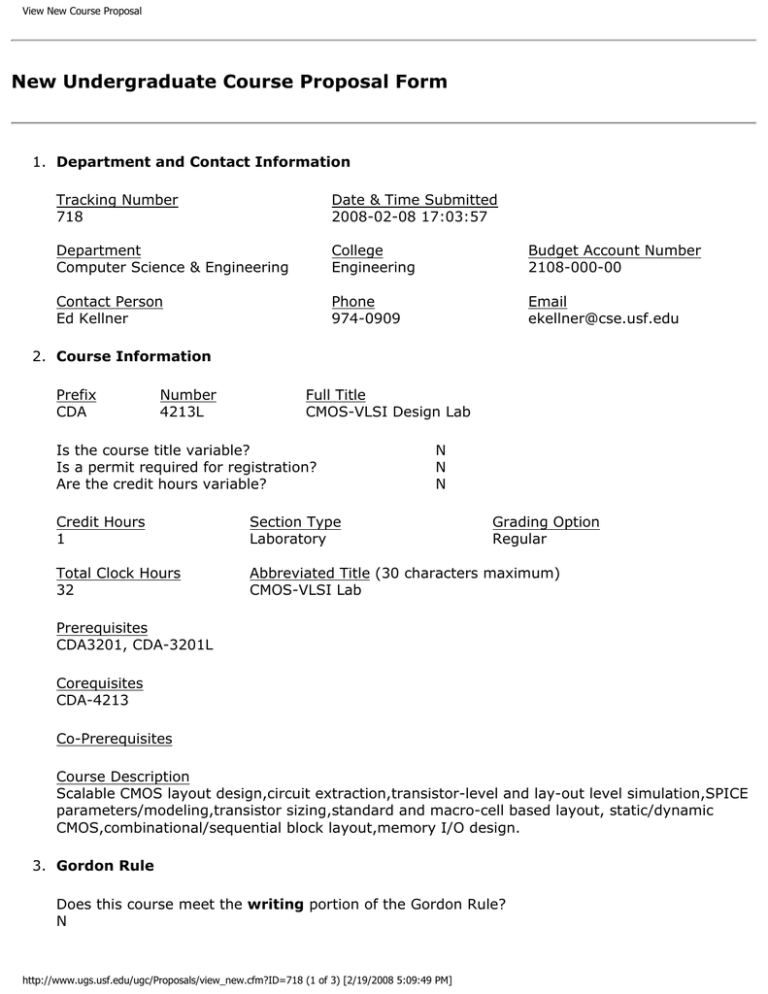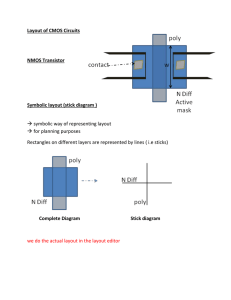
View New Course Proposal
New Undergraduate Course Proposal Form
1. Department and Contact Information
Tracking Number
718
Date & Time Submitted
2008-02-08 17:03:57
Department
Computer Science & Engineering
College
Engineering
Budget Account Number
2108-000-00
Contact Person
Ed Kellner
Phone
974-0909
Email
ekellner@cse.usf.edu
2. Course Information
Prefix
CDA
Number
4213L
Full Title
CMOS-VLSI Design Lab
Is the course title variable?
Is a permit required for registration?
Are the credit hours variable?
N
N
N
Credit Hours
1
Section Type
Laboratory
Grading Option
Regular
Total Clock Hours
32
Abbreviated Title (30 characters maximum)
CMOS-VLSI Lab
Prerequisites
CDA3201, CDA-3201L
Corequisites
CDA-4213
Co-Prerequisites
Course Description
Scalable CMOS layout design,circuit extraction,transistor-level and lay-out level simulation,SPICE
parameters/modeling,transistor sizing,standard and macro-cell based layout, static/dynamic
CMOS,combinational/sequential block layout,memory I/O design.
3. Gordon Rule
Does this course meet the writing portion of the Gordon Rule?
N
http://www.ugs.usf.edu/ugc/Proposals/view_new.cfm?ID=718 (1 of 3) [2/19/2008 5:09:49 PM]
View New Course Proposal
If you checked "yes" above, specify how the 6,000 words will be covered (exams, papers).
N/A
Does this course meet the computation portion of the Gordon Rule?
N
4. Justification
A. Indicate how this course will strengthen the Undergraduate Program. Is this course necessary
for accreditation or certification?
This lab is a compliment to CDA-4213. It allows hands-on implimentation of
concepts discussed in lecture. Students learn state-of-the-art design tools, such as
CADENCE and SYNOPSYS. Students will use procedures currently used in industry.
B. What specific area of knowledge is covered by this course which is not covered by courses
currently listed?
This is the labratory portion of an engineering design course. Labratory work is
essential to impliment engineering design. This course also teaches design tools not
used in other courses.
C. What is the need or demand for this course? (Indicate if this course is part of a required
sequence in the major.) What other programs would this course service?
This course becomes a required course in the Fall 2008 catalog. It is required for all
Computer Engineering majors. The current program has a lecture-lab combination,
but that does not allow sufficient labratory experience. The normal demand for this
course as an elective is 25-30 students/year. This course is also applicable to
electrical engineering majors.
D. Has this course been offered as Selected Topics/Experimental Topics course? If yes, what was
the enrollment?
No. It was part of CDA-4213, which has a normal enrollment of 25.
E. How frequently will the course be offered? What is the anticipated enrollment?
Once a year. It will part of a two-course sequence for computer hardware design.
Enrollment will depend on the number of majors, but 25-30/year is anticipated.
F. Do you plan to drop a course if this course is added? If so, what will be the effect on the
program and on the students? (Please forward the nonsubstantive course change form regarding
the course to be deleted to the Council secretary.)
No. This course helps to complete the number of required hours for the major
without hardship on the student.
G. What qualifications for training and/or experience are necessary to teach this course? (List
minimum qualifications for the instructor.)
http://www.ugs.usf.edu/ugc/Proposals/view_new.cfm?ID=718 (2 of 3) [2/19/2008 5:09:49 PM]
View New Course Proposal
Masters degree in Computer Engineering or Electrical Engineering, with experience
in CMOS-VLSI design. Ph.D preferred.
5. Other Course Information
A. Objectives / Outcomes
To train students to utilize state-of-the-art design tools/Students will learn
CADENCE, SPICE, SYNOPSYS, and NONOSIM tools to aid in design (CAD tools). To
learn CMOS-VLSI layout design/Students will understand different layout design
techniques. To understand modular, scalable and bit-sliced VLSI layout/Students will
understand how and when to use each type of layout. To understand proper design
constraints/Students will understand parameters for area, speed and powerconsumption and how to apportion each for best utilization.
B. Major Topics
- Basic Layout design and utilization of Layout editior/CMOS transistor, MOS switch
behavior, transistion gates, CMOS invertor -Design Rule Check/Lambda-based
design rules, DRC check, Resistance and Capacitance Extraction. Transistor
extraction - SPICE modeling & Circuit Simulation - Delay analysis and optimimation Power analysis and optimization - Basic CMOS Cell Library Design - Bit-sliced Design
- Static and Dynamic CMOS -Datapath Design & Controller Design
C. Textbooks
CMOS-VLSI Design, with VHDL, Weste/Eshraghian, 2005, Pearson Publishing Modern
VLSI Design, Wolf, 2002, Pearson Publishing
6. Syllabus
Your college will forward an electronic copy of your syllabus to Undergraduate Studies when your
course is approved for submission.
http://www.ugs.usf.edu/ugc/Proposals/view_new.cfm?ID=718 (3 of 3) [2/19/2008 5:09:49 PM]
CDA 4213L: CMOS VLSI Design Lab
Instructor:
Instructor:
Dr. Srinivas Katkoori
Office:
ENB 316
Office Hours: TBA
Phone: 974-5737
Email:
katkoori@cse.usf.edu
Class Room & Timings: ENB 214 MW 11:00am–12:15pm
Course Catalog Description: Scalable CMOS layout design, circuit extraction, transistor-level and
layout-level Simulation, SPICE parameters and modeling, bit sliced design, transistor sizing,
standard cell and macro-cell based layout, static and dynamic CMOS, combinational & sequential
block layout, memory I/O design, basic CMOS cell library design, layout area minimization, power
analysis & optimization, and timing.
Prerequisites (No Exceptions):
Computer Logic Design (CDA 3201)
Computer Logic Design Lab (CDA 3201L)
Co-requisites (No Exceptions):
CMOS VLSI Design (CDA 4213)
This lab supplements the CMOS-VLSI design (CDA 4213) lecture class. The concepts taught in
the lecture class will be practiced in this lab.
Objectives:
1. Practice and learn state-of-the-art VLSI Layout editor
2. Proficient in writing SPICE stimuli and analyzing SPICE output
3. Analyze the trade-offs between area, speed, and power consumption.
4. Experience with integration of a custom IC design with a PAD frame
5. Validate the CMOS transistor behavior learnt in the lecture class
6. Use bit-sliced based design style learnt in lecture class, to implement parameterized
component library
7. Analyze a given IC specification and implement it using standard design flow taught in the
lecture class.
Learning Outcomes:
The students would know the basic concepts in computer chip design and have the experience of
design and verification of small and medium scale VLSI chips and obtain insights into the various
issues of VLSI technology and computer chip design
Course Textbook:
“Principles of CMOS VLSI Design: A Systems Perspective,” N. Weste & D. Harris, Third Edition, Pearson
Addison-Wesley, 2004, ISBN 0-321-14901-7.
1
Grade Distribution:
There will be 6 Lab Assignments (each worth 10%) and one final project (worth 40%). The final
project will be a custom IC design that will be fabricated using MOSIS services.
Grading Policy:
A+:
> 95%
B+:
84-87%
C+:
74-77%
F:
< 65%
A:
90-95%
A-:
B:
80-84%
C:
70-74%
87-90%
B-:
77-80%
C-:
65-70%
Topics:
1. Basic Layout Design and Introduction to Layout Editor
2. Design Rule Check and Circuit Extraction
3. SPICE Modeling and Circuit Simulation
4. Delay Analysis and Optimization
5. Power Analysis and Optimization
6. Basic CMOS Cell Library Design – Bit-sliced design
7. Static and Dynamic CMOS
8. Memory Design
9. Datapath Design & Controller Design
10. PAD Frame Integration
General Policies:
Academic dishonesty will not be tolerated and the student, in question, will be dealt
with in accordance with the University policies.
If you need any special accommodation according to the American Disability Act,
please let me know.
Students who anticipate the necessity of being absent from class due to the observation
of a major religious observance must provide notice of the date(s) in writing by the
second class meeting.
Good Luck!!
2



